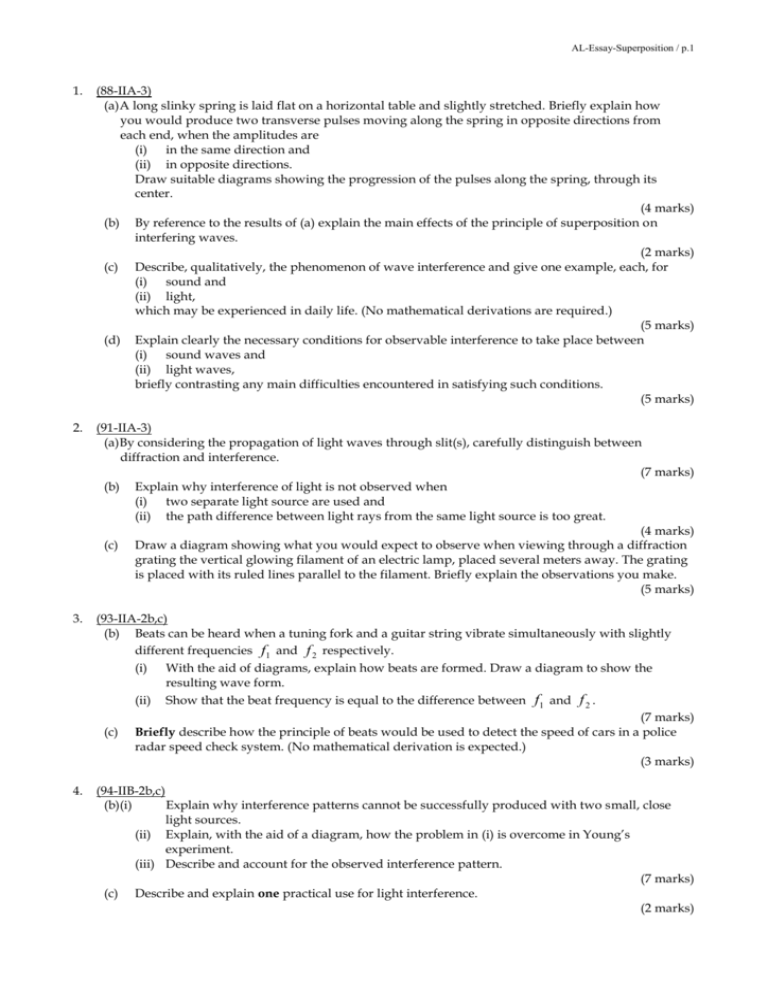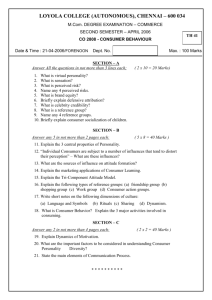Superposition
advertisement

AL-Essay-Superposition / p.1 1. (88-IIA-3) (a) A long slinky spring is laid flat on a horizontal table and slightly stretched. Briefly explain how you would produce two transverse pulses moving along the spring in opposite directions from each end, when the amplitudes are (i) in the same direction and (ii) in opposite directions. Draw suitable diagrams showing the progression of the pulses along the spring, through its center. (4 marks) (b) By reference to the results of (a) explain the main effects of the principle of superposition on interfering waves. (2 marks) (c) Describe, qualitatively, the phenomenon of wave interference and give one example, each, for (i) sound and (ii) light, which may be experienced in daily life. (No mathematical derivations are required.) (5 marks) (d) Explain clearly the necessary conditions for observable interference to take place between (i) sound waves and (ii) light waves, briefly contrasting any main difficulties encountered in satisfying such conditions. (5 marks) 2. (91-IIA-3) (a) By considering the propagation of light waves through slit(s), carefully distinguish between diffraction and interference. (7 marks) (b) Explain why interference of light is not observed when (i) two separate light source are used and (ii) the path difference between light rays from the same light source is too great. (4 marks) (c) Draw a diagram showing what you would expect to observe when viewing through a diffraction grating the vertical glowing filament of an electric lamp, placed several meters away. The grating is placed with its ruled lines parallel to the filament. Briefly explain the observations you make. (5 marks) 3. (93-IIA-2b,c) (b) Beats can be heard when a tuning fork and a guitar string vibrate simultaneously with slightly different frequencies f1 and f 2 respectively. (i) With the aid of diagrams, explain how beats are formed. Draw a diagram to show the resulting wave form. (ii) Show that the beat frequency is equal to the difference between f1 and f 2 . (7 marks) (c) Briefly describe how the principle of beats would be used to detect the speed of cars in a police radar speed check system. (No mathematical derivation is expected.) (3 marks) 4. (94-IIB-2b,c) (b)(i) Explain why interference patterns cannot be successfully produced with two small, close light sources. (ii) Explain, with the aid of a diagram, how the problem in (i) is overcome in Young’s experiment. (iii) Describe and account for the observed interference pattern. (7 marks) (c) Describe and explain one practical use for light interference. (2 marks) AL-Essay-Superposition / p.2 5. (95-IIB-3a,b) (a)Unpolarised sunlight is incident horizontally on air molecules around O in the earth’s atmosphere. Part of the light is transmitted horizontally and part is scattered vertically downward. (b) 6. Briefly explain which ray, the transmitted one or the scattered one, is plane polarised and give the direction of the electric field vector for this ray. Describe a method to identify this polarised light ray. (5 marks) Given an account of an everyday example involving polarised light. (3 marks) (95-IIB-5a) (a) Describe an experiment for measuring the wavelength of monochromatic light using a spectrometer and a diffraction grating with a known grating spacing. (4 marks) 7. (97-IIB-2a) (a) Plane monochromatic light waves of wavelength are incident normally onto a plane transmission grating of slit separation d to produce an interference pattern. (i) Using the principle of superposition describe briefly how the principal maxima are formed and deduce the formula for the angular positions of the principal maxima. (ii) It is preferable to measure the wavelength of light by using a plane transmission grating rather than using a double slit. Explain briefly. (5 marks) 8. (99-IIB-2) (a) (i) With the aid of a diagram, explain how stationary waves are formed. (ii) Explain the following by referring to various phenomena of waves: (I) Radio waves of long wavelengths can propagate long distances. (II) The voice of one of your teachers can be heard and identified before he enters the classroom. (III) Two violin players are playing the same note together for a few seconds and a listener finds that the intensity of the sound seems to vary with time. (IV) A radio receiver seems to works better in some parts of a room than in other parts. (V) Polaroid sunglasses can effectively reduce the glare of the sun reflected from the sea. (10 marks) (b) You are asked to measure the wavelength of red light using a diffraction grating. With the aid of a diagram, describe how you would carry out the experiment and state any precautions. List the measurements that you would take and the major source of error. (6 marks) 9. (00-IIB-2b) (b) Young’s double slit experiment shows that light propagates as a wave motion. (i) Briefly discuss the precautions of the experiment and the requirements on the set-up in order that best results are obtained when a filament lamp is used. (No need to describe the procedures of the experiment.) (ii) Explain why the two slits cannot be replaced by two light bulbs. (6 marks) AL-Essay-Superposition / p.3 10. (01-IIB-2) (a) Distinguish between mechanical and electromagnetic waves in terms of their nature and propagation. State the factors governing the speed of mechanical waves in a solid. (3 marks) (b) (i) Describe an experiment, involving a double-slit arrangement, to demonstrate the wave nature of light and to estimate its wavelength. (ii) What further evidence would suggest that a light wave is (I) electromagnetic and (II) transverse? (7 marks) (c) What is the principle of superposition? Use the principle to explain (i) the formation of beats and (ii) the formation of stationary waves. (6 marks) 11. (02-IIB-2a) (a) (i) With the aid of a diagram, describe an experiment to demonstrate the interference of a 3 cm microwave using one microwave transmitter. State the appropriate spatial arrangement of the apparatus and briefly explain the experimental result. (ii) State and explain a practical application involving the interference of waves. 12.. (04-IIB-2) (a) Describe how you would demonstrate the existence of electromagnetic radiation just beyond the two ends of the visible spectrum. (5 marks) (b) What is meant by the diffraction of light? Discuss qualitatively how the size of the obstacle or aperture affects diffraction. Explain whether using red light or blue light can minimize diffraction effects when photographing tiny objects through a microscope. (5 marks) (c) (i) For a parallel beam of light incident normally on a diffraction grating, show, with the aid of a diagram, how the diffracted waves reinforce with each other strongly in certain directions. (ii) State TWO advantages of a diffraction grating compared with a prism for the study of spectra. (6 marks)







